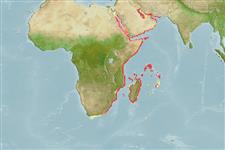>
Eupercaria/misc (Various families in series Eupercaria) >
Haemulidae (Grunts) > Plectorhinchinae
Etymology: Plectorhinchus: Greek, plektos = plaited + Greek, rhyngchos = snout (Ref. 45335).
More on author: Klunzinger.
Environment: milieu / climate zone / depth range / distribution range
Ecología
marino asociado a arrecife; rango de profundidad 2 - 80 m (Ref. 9710). Tropical; 30°N - 36°S, 19°E - 62°E
Western Indian Ocean: Persian Gulf (Ref.80050) and Red Sea to Transkei in South Africa, Seychelles (Ref. 9710), and Mauritius.
Length at first maturity / Tamaño / Peso / Age
Maturity: Lm 26.0 range ? - ? cm
Max length : 60.0 cm TL macho / no sexado; (Ref. 2799); edad máxima reportada: 14 años (Ref. 92948)
Espinas dorsales (total): 12; Radios blandos dorsales (total): 17-18; Espinas anales 3; Radios blandos anales: 7 - 8. Adults dark grey with orange-red lips and opercle edge; fins dark, membrane at front of dorsal fin narrowly black. Juveniles colorful (Ref. 2799).
Found over rocks and corals (Ref. 5213), as well as shallow weedy areas. Stomach contents of specimens collected from Iraq composed mainly of benthic organisms including crustaceans (Ref. 97537). Solitary or in small groups close to shelter (Ref. 9710). Marketed fresh. Maximum depth reported taken from Ref. 9773.
Life cycle and mating behavior
Madurez | Reproducción | Puesta | Huevos | Fecundidad | Larva
Oviparous, distinct pairing during breeding (Ref. 205).
Sousa, M.I. and M. Dias, 1981. Catálogo de peixes de Moçambique - Zona Sul. Instituto de Desenvolvimento Pesqueiro, Maputo. 121 p. (Ref. 5284)
IUCN Red List Status (Ref. 130435)
Threat to humans
Harmless
Human uses
Pesquerías: comercial
Más información
ReferenciasAcuiculturaPerfil de acuiculturaRazasGenéticaElectrophoresesheritabilidadEnfermedadesProcesamientoNutrientsMass conversion
ColaboradoresImágenesStamps, Coins Misc.SonidosCiguateraVelocidadTipo de nataciónSuperficie branquialOtolitosCerebrosVisión
Herramientas
Special reports
Download XML
Fuentes de Internet
Estimates based on models
Preferred temperature (Ref.
123201): 24.6 - 28.5, mean 27.1 °C (based on 444 cells).
Phylogenetic diversity index (Ref.
82804): PD
50 = 0.5000 [Uniqueness, from 0.5 = low to 2.0 = high].
Bayesian length-weight: a=0.01445 (0.00856 - 0.02440), b=2.98 (2.83 - 3.13), in cm total length, based on LWR estimates for this species & Genus-body shape (Ref.
93245).
Nivel trófico (Ref.
69278): 4.0 ±0.66 se; based on food items.
Resiliencia (Ref.
120179): Bajo, población duplicada en un tiempo mínimo de 4.5-14 años (tm=1.8; K=0.87-0.95; tmax=14).
Fishing Vulnerability (Ref.
59153): Moderate vulnerability (44 of 100).
Nutrients (Ref.
124155): Calcium = 34 [12, 64] mg/100g; Iron = 0.53 [0.28, 1.02] mg/100g; Protein = 19.7 [17.8, 21.5] %; Omega3 = 0.127 [0.070, 0.211] g/100g; Selenium = 30 [18, 53] μg/100g; VitaminA = 63.6 [26.3, 155.1] μg/100g; Zinc = 0.93 [0.64, 1.43] mg/100g (wet weight);
